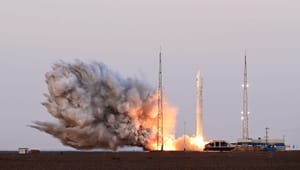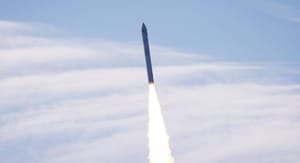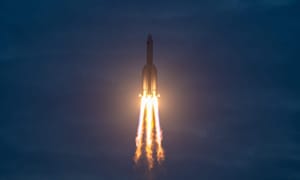
In the past week, five rockets have blasted off from China's various launch sites carrying two dozen satellites into orbit. These launches also bring China's total number of launches this year up to 45!
September 19th - Long March 3B/E
Beginning the busy week of launches was a Long March 3B/E lifting off from Launch Complex 2 at the Xichang Satellite Launch Center. Onboard the rocket for this launch were the 59th and 60th BeiDou satellites heading to medium Earth orbit.

These satellites were also the last of the third generation BeiDou satellites as effort is shifted toward the next generation of the network. The two final satellites for the third generation also carried some upgrades such as improved atomic clocks and new inter-satellite link terminals.
Deployment of the 59th and 60th BeiDou was successful after the Yuanzheng-1 upper-stage performed its burns to place the satellites into 21,882 x 22,234 kilometers and 21,537 x 22,199 kilometers orbits respectively, with an inclination of 55.0 degrees, according to astronomer Jonathan McDowell.
September 20th - Long March 2D
The second Long March launch of the week occurred from Launch Site 9 at the Taiyuan Satellite Launch Center into some dense fog allowing the rocket to disappear into sun-synchronus orbit.

This Long March 2D launch carried six Jilin-1 (吉林一号) satellites as part of the Jilin-1 Kuanfu02B (吉林一号宽幅02B) group. These satellites are believed to have imaging resolutions between 0.5 and 4 meters as part of Changguang Satellite Technology's (长光卫星技术股份有限公司) broader satellite fleet of over 130 satellites.
Four Kuanfu satellites were in orbit before September 20th's launch having been launched in January 2020, July 2021, May 2022, and August 2023 respectively.
September 20th - Kuaizhou-1A
Hours after the previous launch, ExPace's Kuaizhou-1A vehicle blasted off from its mobile launch platform at the Xichang Satellite Launch Center heading for low Earth orbit.

The Kuaizhou-1A vehicle carried four Tianqi (天启) Internet-of-Things satellites for Guodian Gaoke's (国电高科) constellation of the same name. This constellation aims to provide internet and communications connections to areas unserved by terrestrial services and enhances automated transportation services for taxis, drones, and shipping port operations. Currently, 32 satellites are in orbit with six more satellites expected to launch for the constellation.
Kuaizhou-1A was flying its 27th mission with launch on the 20th, and the 33rd for ExPace.
September 24th - Jielong-3
A sea launch also occurred during the week with a Jielong-3 lifting off from a sea launch platform off of the coast of Haiyang, in the province of Shandong in eastern China. This launch had the vehicle fly to a sun-synchronous orbit.

A variety of payloads were onboard for this launch. These included Tianyi-41 (天仪41), a 285-kilogram synthetic aperture radar satellite from Zhangye Constellation Space Technology (张掖星座空间科技有) with an imaging resolution of 1 meter. Another payload was Luojia-4 01 (珞珈四号01), a 60-kilogram imaging satellite developed by the People's Hospital of Wuhan University (武汉大学人民医院健), which is equipped with both a visible light hyperspectral camera and an ultraviolet multispectral camera. Additionally, Fudan-1 (复旦一号), a research satellite, carried a solar ultraviolet spectrometer and a millimeter-wave atmospheric humidity profiler for observing the Sun and Earth.
The Xingshidai-21 (星时代21) and Xingshidai-22 (星时代22) technological demonstration spacecraft were also launched to verify a two-way laser-based communication system capable of ten gigabits per second. Xingshidai-15 (星时代15), another technological demonstration spacecraft, was equipped with an optical camera and high-performance computing hardware to test a ‘space server’ and train an AI model in space. Finally, Tianyan-15 (天雁15) was onboard as a technology demonstration spacecraft designed to image Earth and conduct onboard data processing and compression of these images.
Other spacecraft on board the rocket were Yuxing-2 05 (驭星二号05) and Jitianxing-A01 (吉天星A01). Yuxing-2 05 may be another name for the Luojia-4 01 spacecraft.
This launch was also the 4th flight of Jielong-3, which is offered commercially by a subsidiary of the China Academy of Launch Vehicle Technology.
September 24th - Kinetica-1
Wrapping up the busy week of launches was CAS Space's Kinetica-1 vehicle lifting off from Launch Site 130 at the Jiuquan Satellite Launch Center, and flying to sun-synchronus orbit. This final launch carried five satellites for three customers.

The first of these satellites were Zhongke-1 01 (中科卫星01) and Zhongke-1 02 (中科卫星02) which are the first two spacecraft for China Science and Technology Satellite's (中科卫星) AIRSAT constellation. These two satellites are Ku-band synthetic aperture radar spacecraft with an imaging resolution of approximately 1 meter. Once commissioned in orbit, they will provide data for agriculture, disaster prevention, urban planning, and natural resource utilization.
Another satellite onboard was from Changguang Satellite Technology (长光卫星技术股份有限公司) adding to the aforementioned Jilin-1 satellite fleet. This satellite is Jilin-1 SAR01A (吉林一号SAR01A) and is a remote-sensing satellite that will utilize X-band observations to achieve sub-meter imaging resolution in all weather conditions at any point in the day.
Two more remote sensing satellites were onboard, called Yunyao-1 21 (云遥一号21) and Yunyao-1 22 (云遥一号22) and developed by Tianjin Yunyao Aerospace Technology (功将天津云遥宇航科). These satellites join the company's meteorological satellite constellation to provide data on humidity, pressure, atmospheric temperature, and ionospheric electron density to improve weather forecasts.
Like Jielong-3, this was the 4th flight of Kinetica-1 and continued the vehicle's high-accuracy orbital insertions.
Still on for 100 launches?
Back in February the China Aerospace Science and Technology Corporation released its 'blue paper' outlining various goals for 2024. One of these goals was to conduct 100 launches, with state-owned corporations launching 70 times and the privately held launch providers conducting 30 launches.
With a little over three months left this year the chance for China to launch 55 more times is quite slim, as a launch would need to occur every 1.76 days at the time of writing.
It is also rumored that due to a combination of payload readiness, launch pad turnaround time, and Super Typhoon Yagi hitting the Wenchang launch sites, that this objective is no longer as high as one-hundred. What it has been reduced to is unknown outside of the China Aerospace Science and Technology Corporation.



